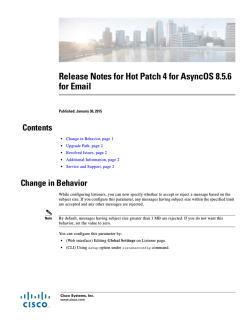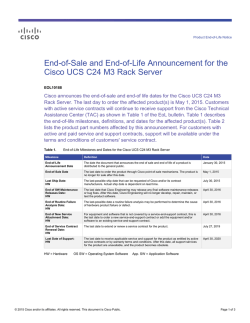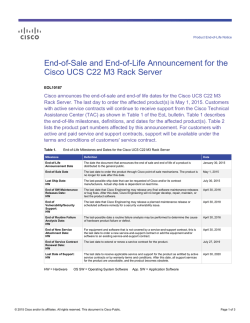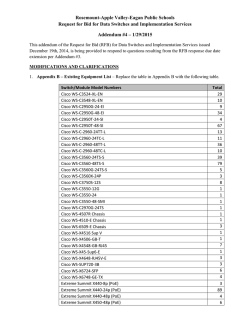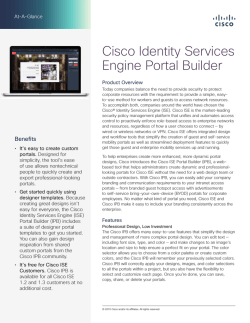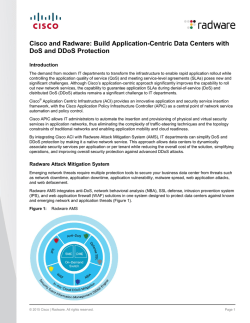
Virtualized Video Infrastructure with Harmonic VOS and Cisco UCS
White Paper Virtualized Video Infrastructure with Harmonic VOS and Cisco UCS What You Will Learn Harmonic Electra™ XVM is a virtualized video processing application that replaces discrete, hardware-based appliances. Hosted on the Cisco Unified Computing System™ (Cisco UCS®), the application provides a compelling virtualized video infrastructure (VVI) solution that brings agility and lower total cost of ownership (TCO) to media operations. With both unified fabric and unified management, the Cisco® and Harmonic solution is easy to deploy, scale, and manage, leaving organizations free to focus on strategic business opportunities. © 2015 Cisco and/or its affiliates. All rights reserved. This document is Cisco Public information. Virtualized Video Infrastructure with Harmonic VOS and Cisco UCS January 2015 Contents Introduction......................................................................................................3 The Rise of Virtualized Video Infrastructure.......................................................4 Virtualized Video Infrastructure Implementation.....................................................5 Harmonic VOS and Electra XVM on Cisco UCS.................................................6 Harmonic VOS and Electra XVM: Software-Based Video Processing....................6 Harmonic Electra XVM on Cisco UCS....................................................................8 Unified Solution Management................................................................................8 Cisco UCS Manager................................................................................................................. 10 Harmonic NMX Digital Service Manager................................................................................... 10 Cisco and Harmonic Reference Configurations.................................................11 Server and Software Requirements.......................................................................11 90-Channel Small-Scale Cisco UCS VVI Reference System.................................12 1080-Channel Large-Scale Cisco UCS VVI Reference System............................12 Achieving Real-World Efficiency............................................................................12 Conclusion.......................................................................................................13 For More Information........................................................................................14 © 2015 Cisco and/or its affiliates. All rights reserved. This document is Cisco Public information. Page 2 Virtualized Video Infrastructure with Harmonic VOS and Cisco UCS White Paper January 2015 Introduction Traditional, fixed-purpose hardware-defined video processing and delivery solutions are costly to deploy and maintain. They require a large number of discrete components with complex cabling to stream video from one processing unit to another. They are rigid systems that present the risk of downtime when they are reconfigured to add new capabilities or new channels. Virtual video infrastructure (VVI) offers a different approach, with operational and economic benefits for video production environments compared to traditional hardware-based approaches. The virtualized Harmonic VOS™ media processing architecture running on Cisco Unified Computing System™ (Cisco UCS®) is an inherently open ecosystem that provides greater flexibility at lower cost. With VVI, you can get more value from your infrastructure and achieve the full monetization potential of your content. You can choose server hardware and software components that meet technical and budgetary requirements. You also gain the agility to scale infrastructure quickly without compromising the availability of live video services. You can create disaster-recovery sites that serve other IT functions until they are needed as substitute head ends. This innovative approach not only allows linear broadcast 24 hours a day, every day; it also allows you to rapidly deploy and scale additional encoding applications for live events, with the capability to later repurpose this capacity for other tasks as needed. A Harmonic VOS and Cisco UCS VVI deployment offers a path from discrete proprietary video appliances to integrated and virtualized video services infrastructure. The first product for the VOS architecture is the Harmonic Electra™ XVM virtualized media processor for live, high-quality video broadcast services. Running on Cisco UCS B200 M4 Blade Servers in VMware ESXi virtual machines, Electra XVM is a multiple-resolution, multiple-standard, multiple-profile, multiple-service, and multiple-channel media processor that operates as a part of a complete video processing and delivery network. The solution can easily scale to support hundreds or even thousands of high-definition (HD) channels with a massively scalable Cisco UCS solution that can be rapidly deployed. Comprehensive and integrated infrastructure management is provided with VMware vRealize Operations in © 2015 Cisco and/or its affiliates. All rights reserved. This document is Cisco Public information. Page 3 Virtualized Video Infrastructure with Harmonic VOS and Cisco UCS January 2015 combination with Cisco UCS Manager for true stateless hardware abstraction, with Harmonic NMX Digital Service Manager providing Electra XVM application provisioning and redundancy. The Rise of Virtualized Video Infrastructure In the past, dedicated hardware was required for video processing, but the constant performance improvements of industry-standard processors have resulted in servers powerful enough to propel software-based video applications. These computational resources are causing a shift in video processing and distribution toward IT-centric data center infrastructure, through VVI. Moving to Harmonic Electra XVM with Cisco UCS yields dramatically simplified deployments (Figure 1) and significant benefits compared discrete hardware-based approaches: • Independence from custom hardware: The solution virtualizes video processing applications with industry-standard processors and servers. This feature enables significant cost savings while allows operators to build and maintain more efficient and cost-effective video processing workflows. With centralized management of worldwide resources, operators can define and distribute new video channels globally in a fraction of the time and cost required today. • Savings in capital expenditures (CapEx) and operating expenses (OpEx): The use of industry-standard hardware such as Cisco UCS B-Series Blade Servers can result in 30 to 40 percent lower total cost of ownership (TCO) over the life of the video system. This savings is achieved through more flexible operations, reduced time to launch new services, and lower CapEx and OpEx than for traditional video processing running on custom appliances. Discrete Hardware-Based Video Processing Infrastructure SCTE-104 Inserter Graphics Playout Server SD Encoder VVI on Cisco UCS HD Encoder SCTE-104 Inserter Graphics UCS B22 M3 HD AVC UCS B22 M3 CONSOLE HVN MW East UCS B22 M3 Graphics MW Encoder SCTE-104 Inserter Graphics MW Encoder SCTE-104 Inserter Graphics Playout Server HD Encoder HVN HD East - AVC HVN SD East Mux CONSOLE UCS B22 M3 CONSOLE UCS B22 M3 CONSOLE UCS B22 M3 CONSOLE CONSOLE Cisco UCS Blade Server Chassis HVN HD East HVN HD West HVN SD West HD AVC Graphics Origin HVN MW West CONSOLE UCS B22 M3 CONSOLE UCS B22 M3 HVN HD West - AVC SD Encoder Figure 1. Running VVI on Cisco UCS Dramatically Simplifies Video Processing and Delivery Deployments © 2015 Cisco and/or its affiliates. All rights reserved. This document is Cisco Public information. Page 4 Virtualized Video Infrastructure with Harmonic VOS and Cisco UCS January 2015 • Reduced space, power, and cooling requirements: With the shift to virtualization and software-defined environments, you can reduce space, power, equipment, and personnel requirements by 25 to 30 percent. Simultaneously, you gain flexibility, allowing you to manage and allocate resources according to changing business and operational requirements. • Greater business agility: Flexible selection and rapid deployment of video application deployment means that your organization can be more agile, responsive, and profitable. You can define and distribute new video channels globally in a fraction of the time and cost required today. The dynamic and modular nature of this virtualized infrastructure allows you to readily introduce new services and augment existing services through the licensing of additional virtualized applications. VVI also offers a flexible deployment infrastructure that supports the repurposing of technology and accelerates time to market. Virtualized Video Infrastructure Implementation VVI decouples video processing applications from the underlying physical infrastructure. This separation allows you to reap the benefits of virtualization that IT departments have been enjoying for years. You can: • Exploit the rapid increase in processing power and rapidly dropping costs of general-purpose server hardware • Decouple server purchases from service deployment with a virtualization pool that can incorporate the latest, most powerful servers, while still accommodating hardware purchased for your first implementation • Scale by rapidly incorporating new servers into the virtualization cluster • Use standard IT tools to gain visibility across the entire infrastructure into the health of your virtual networks, hosts, virtual machines, and blade servers and the video software that runs on them • Centralize troubleshooting through standard tools that your IT department already knows how to use Harmonic Electra XVM running on a unified pool of Cisco UCS blade servers helps simplify media processing head-end physical infrastructure and management. Deployment on Cisco UCS provides benefits beyond those that other server vendors may offer: • Less complex physical network connectivity translates directly to lower CapEx, because fewer switch ports and cables are required. You may need as little as 25 percent of the connectivity resources that would be used in a traditional onerack-unit (1RU) server-based environment. • Cisco® Unified Fabric requires fewer connections to each blade server because each connection supports network, storage, and management traffic. • The Cisco UCS bade server chassis supports massive I/O bandwidth to each blade server, and it has already supported multiple generations of Intel® Xeon® processors without challenging its power, cooling, and I/O capacity. • Automated deployment and rapid scaling means that you can easily add resources to support a growing business with little effort. With Cisco UCS, you © 2015 Cisco and/or its affiliates. All rights reserved. This document is Cisco Public information. Page 5 Virtualized Video Infrastructure with Harmonic VOS and Cisco UCS January 2015 don’t need to restructure your network infrastructure when you add a new server or chassis to the system. • Real-time repurposing of Cisco UCS servers and of other hardware through virtualization offers fast and automated disaster recovery within a single cluster and across multiple sites. This flexibility gives you flexibility to adapt smoothly to the unique demands of high-intensity live events. Harmonic VOS and Electra XVM on Cisco UCS Harmonic Electra XVM is flexible video processing software designed to run in a virtual machine, rather than on custom hardware. An abstraction layer separates the applications running on the virtual machine from the supporting computing, storage, and networking hardware. In some media processing applications, multiple virtual machines may be deployed on a single blade server. Figure 2 presents a high-level architectural view showing how Harmonic Electra XVM is deployed on Cisco UCS. • Encoding application: At the application layer, Harmonic Electra XVM runs on a virtualized Linux OS instance. • Hypervisor: The solution employs the VMware ESXi hypervisor to create a virtual machine with virtualized CPU, memory, network interface card, and storage. • Physical layer: Cisco UCS with Cisco UCS B200 M4 Blade Servers provide physical CPU, memory, network, and storage resources. VIRTUAL HOST APPLICATIONS RUNNING ON VIRTUAL MACHINE Harmonic Electra XVM Encoding Application VMWARE ESXI Hypervisor VM with Virtualized CPU, Memory, NIC, and Storage Virtual Machine Hypervisor Memory CPU NIC ABSTRACTION LAYER Disk PHYSICAL LAYER Cisco UCS B200 M4 Blade Servers (Physical CPU, Memory, NIC, and Storage) UCS B22 M3 UCS B22 M3 CONSOLE UCS B22 M3 Blade Server Physical RAM Memory Physical CPU Processors Physical NIC Cards Physical Disk Storage CONSOLE UCS B22 M3 CONSOLE UCS B22 M3 CONSOLE UCS B22 M3 CONSOLE UCS B22 M3 CONSOLE UCS B22 M3 CONSOLE CONSOLE Figure 2. Harmonic Electra XVM Application Hosted on VMware ESXi Hypervisor and Cisco UCS Harmonic VOS and Electra XVM: Software-Based Video Processing Harmonic VOS unifies the media processing chain for both broadcast and multiscreen applications. Harmonic VOS brings together ingestion, compression, graphics and branding, packaging, and delivery in a single, virtualized, softwarebased platform. The result is a common software platform and architecture for © 2015 Cisco and/or its affiliates. All rights reserved. This document is Cisco Public information. Page 6 Virtualized Video Infrastructure with Harmonic VOS and Cisco UCS January 2015 media processing, simplifying workflows and increasing flexibility for both video content provider and video service provider deployments. The Harmonic VOS architecture helps video content and service providers gain operational efficiency. A common architecture lets you select each function individually or in combination with others. The virtualized model lets you add capacity easily and without disruption at any time. Harmonic VOS capabilities are made available through a robust set of dynamically deployable application modules (Figure 3). Processing, Packaging, and Delivery Ingest Playout Graphics and Branding PURE Compression Multiscreen Multiscreen Multiscreen Harmonic VOS Hypervisor Layer Cisco Unified Computing System Figure 3. Harmonic VOS Function Integration Brings Together a Complete Video Service Processing Capability on a Single Virtualized Software-Based Platform Propelled by the power of Cisco UCS B200 M4 servers, Harmonic VOS provides: • Innovative compression: The core of the VOS platform is the Harmonic PURE Compression Engine, an advanced encoding technology that delivers state-ofthe-art video quality and supports standard-definition (SD) and high-definition (HD) MPEG-2, Advanced Video Coding (AVC), and High-Efficiency Video Coding (HEVC) codecs over constant bit rate (CBR), variable bit rate (VBR), and adaptive bit rate over-the-top (OTT) encoding schemes. Harmonic PURE Compression Engine powers VOS with superior video quality at low bandwidth across both broadcast and multiscreen services. • Software benefits: Coupling Harmonic VOS with Cisco UCS and Linux reliability brings dramatically simplified redundancy and parts sparing. Predictable performance improvements from each new processor generation provide investment protection and continuous improvement in TCO. • Flexible deployment models: The agility of the Harmonic and Cisco UCS technology combination lets organizations move quickly to add coverage for live events and local sports and to extend coverage for multiple camera angles. The capability to rapidly reuse virtualized hardware resources improves utilization, allowing hardware to be used for live, video-on-demand (VOD), and pay-per-use functions, as required by the business. © 2015 Cisco and/or its affiliates. All rights reserved. This document is Cisco Public information. Page 7 Virtualized Video Infrastructure with Harmonic VOS and Cisco UCS January 2015 • Integrated playout: Integrated playout mechanisms provide support for slates and service provider channels. National ad insertion and program switching are also supported. • Advanced graphics: Harmonic Electra XVM also offers a unique set of graphics and branding capabilities tailored to the requirements of content distribution and service delivery. Drawing on the advanced functions of the Harmonic Spectrum ChannelPort integrated channel playout system, organizations can easily add dynamic text, regulatory and station logos, emergency alerts, and branding elements to video channels. Harmonic Electra XVM on Cisco UCS Video processing and deployment requires computational and memory performance along with considerable I/O and network bandwidth and throughput. The Cisco UCS B200 M4 Blade Server is an excellent platform for Harmonic Electra XVM. The blade server platform provides the computing and memory resources necessary to run computationally demanding video processing functions in a virtualized environment. • Single unified system: Cisco UCS is the first data center platform to integrate servers, networking, storage access, and virtualization resources into a single unified system. When you deploy Cisco UCS, you establish the system’s whole infrastructure, so the addition of more servers and chassis doesn’t require any complex cabling or any other networking components, radically simplifying streaming video environments compared to traditional discrete models. • Integrated, embedded management: Cisco UCS Manager makes the system self-aware and self-integrating. When you plug a component into Cisco UCS, it is automatically discovered. Server identity, configuration, and connectivity is abstracted into Cisco UCS service profiles. Associating a service profile with a physical server sets more than 100 configuration variables, all with zero touch. The system can be set up with resource pools that automatically discover and configure new servers as they are inserted into the blade server chassis, automating deployment. In the event of a server failure, a new server can be configured to take on the failed server’s identity in minutes. • Cisco SingleConnect technology: This combination of Cisco technologies combines IP networking, storage access, and management on a single set of cables, dramatically simplifying data center cabling. Cisco SingleConnect technology treats physical server and virtual machines equivalently, so you can run virtualized and nonvirtualized Harmonic Electra XVM instances without the need for any special provisions. The Cisco UCS components illustrated in Figure 4 include the Cisco UCS fabric interconnects, which provide a single point of connectivity and management for the entire system, Cisco UCS fabric extenders, which bring the unified fabric to each blade server chassis, and powerful Cisco UCS B200 M4 Blade Servers, eight of which fit into a single 6RU chassis. Unified Solution Management One of the main aspects of the Cisco and Harmonic solution is that it provides a unified management environment. As shown in Figure 5 and described in the sections that follow, different aspects of the system are managed by tools that are best suited to each task. © 2015 Cisco and/or its affiliates. All rights reserved. This document is Cisco Public information. Page 8 Virtualized Video Infrastructure with Harmonic VOS and Cisco UCS January 2015 Cisco Nexus 6000 Series Switch Cisco UCS 6248UP 48-Port Fabric Interconnect 1 2 3 4 5 6 7 8 9 10 11 12 13 14 15 16 17 18 19 20 21 22 23 24 25 26 27 28 29 30 31 32 1 1 2 3 4 5 6 7 8 9 10 11 12 13 14 15 2 3 4 5 6 7 8 9 10 11 12 13 14 15 16 17 18 19 20 21 22 23 24 25 26 27 28 29 30 31 32 16 1 2 3 4 5 6 7 8 9 10 11 12 13 14 15 16 10-Gbps Unified Fabric UCS B22 M3 UCS B22 M3 CONSOLE UCS B22 M3 CONSOLE UCS B22 M3 CONSOLE UCS B22 M3 Cisco UCS 5108 Blade Server Chassis with 8 Cisco UCS B200 M4 Blade Servers Cisco UCS 2204XP Fabric Extender (at Rear of Chassis) CONSOLE UCS B22 M3 CONSOLE UCS B22 M3 CONSOLE UCS B22 M3 CONSOLE CONSOLE Figure 4. Cisco UCS Components Work Together as a Single Unified System • Cisco UCS Manager provides virtualized infrastructure management. • Harmonic NMX provides application management and provisioning for Harmonic Electra XVM. • VMware vSphere is responsible for provisioning the virtual machines across Cisco UCS. A Cisco UCS Manager plug-in for VMware vRealize Operations (formerly vCenter Operations Management Suite) enables administrators to view, manage, and monitor various aspects of Cisco UCS physical infrastructure through VMware vSphere. Harmonic Electra NMX (Application Management Virtualized Infrastructure Management (Cisco UCS Manager Plugin and VMware vRealize Operations) VIRTUAL HOST VIRTUAL HOST VIRTUAL HOST VIRTUAL HOST VIRTUAL HOST Live Encoding Application Live Encoding Application Live Encoding Application Live Encoding Application Live Encoding Application Virtual Machine Virtual Machine Virtual Machine Virtual Machine Virtual Machine Harmonic Electra XVM Hypervisor VMware ESXi with VMware vSphere ABSTRACTION LAYER Blade Server Blade Server Blade Server Blade Server Blade Server Cisco UCS B200 M4 Blade Servers PHYSICAL LAYER Figure 5. Harmonic NMX Digital Service Manager Works in Combination with Cisco UCS Manager and VMware vSphere to Provide a Unified Management Approach © 2015 Cisco and/or its affiliates. All rights reserved. This document is Cisco Public information. Page 9 Virtualized Video Infrastructure with Harmonic VOS and Cisco UCS January 2015 Cisco UCS Manager Cisco UCS Manager provides a single point of management for the entire system, accessible through an intuitive GUI, command-line interface (CLI), and open XML API. Cisco UCS Manager is based on the following concepts: • Policy-based management helps you better define and implement your own best practices, helping ensure that only consistent, tested, and standards-compliant systems are provisioned. This approach reduces risks from repetitive and errorprone manual tasks and facilitates more dynamic data center infrastructure. • Role-based access control (RBAC) lets you use your existing organizational structure to manage Cisco UCS. Fine-grained action definition enables simplified coordination between roles while restricting access to actions that can jeopardize service uptime. By default, server, network, and storage administrators can make changes appropriate to their roles, and cross-role visibility enhances communication between disciplines. • A “wire once and walk away” model is supported by Cisco SingleConnect technology, allowing you to wire the system once and then manage all I/O and networking configuration through Cisco UCS Manager. For example, you can establish Fibre Channel connectivity to shared storage by enabling Fibre Channel over Ethernet (FCoE) through Cisco UCS Manager and directing Cisco virtual interface cards (VICs) to present Fibre Channel host bus adapters (HBAs) to the servers. • Automated device discovery and Cisco UCS service profiles and templates allow servers to have their identity programmed on demand along with all configuration and connectivity, reducing the potential for human error, improving consistency, and shortening server deployment time. Created by server, network, and storage administrators and stored in the fabric interconnects, service profiles and templates are used by Cisco UCS Manager to automatically configure the server and its network adapters, fabric extenders, and fabric interconnects to support the configuration specified in the service profile. This approach greatly reduces the number of manual steps required to configure servers, network interface cards (NICs), HBAs, and LAN and SAN switches. • Cisco UCS Central Software extends Cisco UCS Manager to enable policies, multitenancy, statistics collection, and backup operations on a global scale. Cisco UCS Central Software aggregates multiple Cisco UCS domains into a common framework that shares the same hardware abstraction and programmatic API. Cisco UCS Central Software supports shared global service profiles, templates, policies, and pools, allowing global control of policies and name spaces for increased compliance. The automation of processes allows data center managers to achieve greater efficiency, agility, and scale, while reducing complexity and risk. Availability and flexibility are retained by not tying multisystem management of potentially thousands of servers to a single nonredundant entity. Harmonic NMX Digital Service Manager Harmonic NMX Digital Service Manager is a video network management solution that encompasses a powerful set of tools for monitoring and managing compressed digital video and audio services, as well as the systems through which these services flow. NMX offers a simple and intuitive interface for creating and modifying channel lineups. It can also be used to set encoding system parameters. The status © 2015 Cisco and/or its affiliates. All rights reserved. This document is Cisco Public information. Page 10 Virtualized Video Infrastructure with Harmonic VOS and Cisco UCS January 2015 of services and infrastructure—including alarms—is passed through to the top level, helping ensure that problems are quickly detected and resolved. Redundancy is also automated. In the context of this virtualized solution, the Harmonic NMX Digital Service Manager server performs application-level management and provisioning, just as the NMX server manages and provisions video applications on dedicated appliances. The NMX server provides the video network group creation, and service configurations, as well as application-level alarm, event, and fault monitoring. Harmonic NMX Digital Service Manager is service-oriented software that works the way the operations themselves work. Its main features include: • Distributed processing for high availability • Representative “input-to-output” GUI and functions • Template and wizard-based system setup • Scalability to any system size With Harmonic NMX Digital Service Manager, the addition, reconfiguration, and removal of services and video application virtual machines is fast, easy, and error free. Templates, wizards, consolidated data views, and powerful cut-and-paste functions are available for both service and system modifications. With the addition of Harmonic any-to-any technology, Harmonic NMX Digital Service Manager allows users to easily modify and deploy new channel lineups in real time with little disruption. A three-pane visual layout gives the operator a quick overview of the service paths through the network elements. Harmonic NMX Digital Service Manager is designed for operations 24 hours a day, every day, and can run on a single system or be distributed across multiple servers for high availability. Cisco and Harmonic Reference Configurations Harmonic and Cisco engineers have developed powerful Cisco UCS building blocks that let you scale Cisco UCS VVI for Harmonic Electra XVM. The sections that follow describe examples of 100- and 1000-channel Harmonic Electra XVM reference configurations based on Cisco UCS. Server and Software Requirements Harmonic recommends servers with the following minimum characteristics for the reference architectures described here: • 2 multicore Intel Xeon processor E5-2600 v3 series CPUs; if you want to run 6 HD applications, Harmonic recommends a minimum of 2 Intel Xeon processor E5-2697 v3 CPUs at 2.6 GHz • At least 16 cores per blade server • At least 32 GB of memory per blade server • Hard disk drives with at least 600 GB of capacity © 2015 Cisco and/or its affiliates. All rights reserved. This document is Cisco Public information. Page 11 Virtualized Video Infrastructure with Harmonic VOS and Cisco UCS January 2015 Required software components include: • VMware ESXi hypervisor • VMware vSphere management (VMware vRealize Operations ) for provisioning and deploying virtual machines • Cisco UCS Manager • Harmonic Electra XVM Open Virtualization Format (OVF) image • Harmonic NMX Digital Service Manager 90-Channel Small-Scale Cisco UCS VVI Reference System Cisco UCS system can easily handle 90 HD channels with Harmonic Electra XVM. Additionally, this configuration can be used as a convenient building block for assembling larger configurations to serve a greater number of channels. Using a total of 16 Cisco UCS B200 M4 Blade Servers equipped with Intel Xeon processor E5-2697 v3 CPUs, the 90-channel small-scale system is composed of: • 1 industry-standard 19-inch rack • 2 6RU Cisco UCS 5108 Blade Server Chassis: one with 7 active blade servers and 1 backup blade server, and another with 8 active blade servers • 2 Harmonic NMX HWP 3E servers (or Harmonic NMX running on similar blade servers) • 2 Cisco UCS 6248UP 48-Port Fabric Interconnects • 2 Cisco UCS 2204XP Fabric Extenders in each blade chassis As described earlier, the system provides considerable redundancy for highavailability operation. One spare blade server is provided as part of the configuration, allowing rapid failover of video processing or delivery services in the event of a blade failure. In addition, dual network paths and redundant network components help ensure that any network failure can be easily recovered from, reducing service interruption. 1080-Channel Large-Scale Cisco UCS VVI Reference System A large-scale 1080-channel system can be built with two Cisco UCS instances interconnected with Cisco Nexus® 6000 Series Switches and managed with Cisco UCS Central Software. The full configuration supporting 1080 HD channels would consist of: • 24 Cisco UCS 5108 Blade Server Chassis • 192 Cisco UCS B200 M4 Blade Servers • 4 Cisco UCS 6248 Fabric Interconnects • 2 Cisco Nexus 6000 Series Switches • 1 VMware vRealize Operations server • Cisco UCS Central Software for multidomain management of Cisco UCS Achieving Real-World Efficiency Comparing a 1080 channel deployment in a VVI environment based on Harmonic Electra XVM and Cisco UCS with a traditional fixed-function video-encoding solution © 2015 Cisco and/or its affiliates. All rights reserved. This document is Cisco Public information. Page 12 Virtualized Video Infrastructure with Harmonic VOS and Cisco UCS January 2015 (with two HD channels per discrete appliance in 1RU) reveals a dramatic reduction in infrastructure complexity. As shown in Figure 6, the required hardware is considerably reduced for a VVI implementation based on Harmonic Electra XVM and Cisco UCS. This case study represents 1080 HD mezzanine sources with one HD and five ABR outputs per input, with 15:1 redundancy. Each blade server (equipped with Intel Xeon processor E5-2697 v3 CPUs) supports six HD channels. 0 500 1000 1500 2000 2500 3000 3500 24 Electra XVM Enclosures 576 Traditional Hardware Encoders 116 Port Count 3456 144 Rack Units 576 81,448 Power (Watts) 259,200 277,912 Cooling (BTU/Hour) 884,427 0 150,000 300,000 450,000 600,000 750,000 900,000 Figure 6. Harmonic Electra XVM Running on Cisco UCS Results in Dramatic Infrastructure Reduction and Simplification Conclusion Today’s discrete fixed-function appliance-based video architecture is both costly to deploy and maintain and complex, difficult, and time consuming to expand. These realities and associated costs increase the time from deployment to results and affect profitability just when media companies need agility to address change, growth, and opportunity. Increasingly capable industry-standard hardware, such as Cisco UCS B200 M4 Blade Servers, provides a compelling alternative in the form of VVI. This softwarebased approach offers numerous operational and economic benefits for video production, with lower TCO and greater agility than traditional discrete appliancebased systems. VVI with Harmonic Electra XVM and Cisco UCS provides modern video production facilities with agile and efficient video service delivery to compete more effectively and benefit from emerging opportunities. © 2015 Cisco and/or its affiliates. All rights reserved. This document is Cisco Public information. Page 13 Virtualized Video Infrastructure with Harmonic VOS and Cisco UCS January 2015 For More Information • For more information about Cisco UCS, please see http://www.cisco.com/go/ucs. • For more information about Harmonic VOS, please see: http://www.harmonicinc.com/content/vos http://www.harmonicinc.com/sites/default/files/VVI_Solution_Brief.pdf • For more information about Harmonic XVM Virtualized Media Processor, please see http://www.harmonicinc.com/product/encoding-transcoding-distribution/ electra-xvm. • For more information about Harmonic NMX video services manager, please see http://www.harmonicinc.com/product/nmx. Americas Headquarters Cisco Systems, Inc. San Jose, CA Asia Pacific Headquarters Cisco Systems (USA) Pte. Ltd. Singapore Europe Headquarters Cisco Systems International BV Amsterdam, The Netherlands Cisco has more than 200 offices worldwide. Addresses, phone numbers, and fax numbers are listed on the Cisco Website at www.cisco.com/go/offices. Cisco and the Cisco logo are trademarks or registered trademarks of Cisco and/or its affiliates in the U.S. and other countries. To view a list of Cisco trademarks, go to this URL: www.cisco.com/go/trademarks. Third party trademarks mentioned are the property of their respective owners. The use of the word partner does not imply a partnership relationship between Cisco and any other company. (1110R) LE-47601-01 01/15
© Copyright 2026
